Tagged with 'Events'


-
Designing with Pearls at CSM 2015 - Part III
Designing with Pearls at CSM 2015 - Part III
Here we feature the final part in a series of short interviews with graduate jewellers designing with pearls at the BA Central Saint Martins Jewellery 2015 show, including in this article – Fiona Kakei Chong, Yuanming Dennis Song, Qinying Queenie Wang and Danya Xie.
For the third year, we have been working with the students of the Central Saint Martins Jewellery Design course. We will be awarding a Winterson Prize to one of the students for ‘The Best Use of Pearls’ at Jewellery Awards Evening on 25th June.
Read about some of the other designers in Part I and Part II of the series and the Winner of the Winterson Prize 2015.
UNTITLED COLLECTION - FIONA KAKEI CHONG
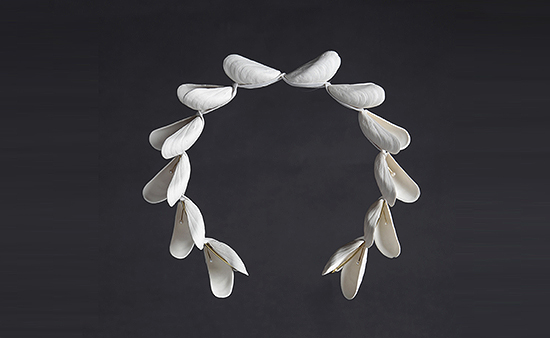
Tell us a little bit about yourself.
I divide my time between three countries, and I like to collect and create things.
What was the inspiration for this collection?
My initial inspiration was the elaborate hairstyles seen on Ancient Roman busts. Seeing Ancient Romans taking hairdressing as seriously as nude bodies, I had this idea of a tribe where its noble women would crown themselves with lots of and solely seashells.
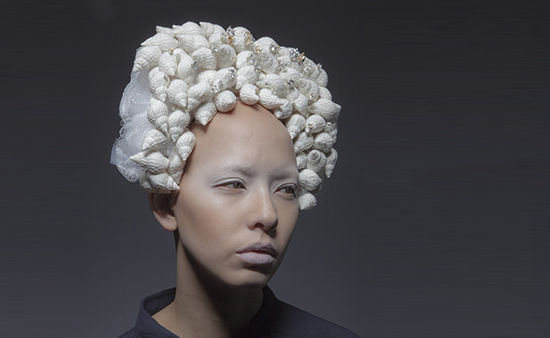
What have you discovered about working with pearls?
As soon as my fingers touch a pearl, their temperatures equalized. It is with its warm and organic feeling, and the contrast with metal and porcelain, that makes a jewellery piece alive.
Which designer or artist do you most admire?
Karl Fritsch. He likes to make ugly rings with precious materials and found objects.
What’s next for you after CSM?
I wish to work for a creative company or jewellery studio.
Who could you imagine wearing your jewellery?
I would like Natalie Portman to be part of the shell tribe.
What is it that makes a piece of jewellery a design classic?
A jewellery piece that is able to draw a line between now and then.
View more of Fiona's work here.
THE BEAUTY OF TIME FLOWING - YUANMING DENNIS SONG
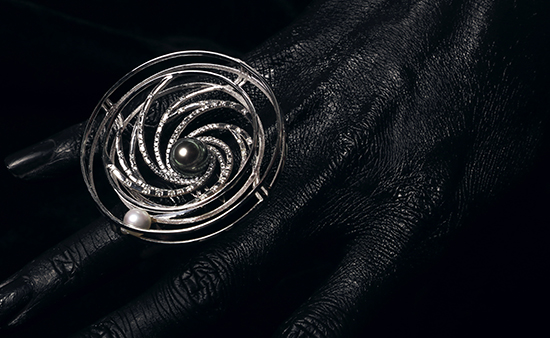
Tell us a little bit about yourself.
I have studied Jewellery design at CSM for 4 years since Foundation and I really enjoy it. My final collection is all about 3D-printed fine jewellery.
I love using pearls in my design, pearls have played significant roles in all the pieces from my final degree show collection.
What was the inspiration for this collection?
Time is a magical thing which can not be seen, touched or felt but everything in this world is experiencing it in every single moment. Time, flowing like a river. Illustrating the flow of time through a piece of jewellery has always been an extremely powerful idea in my mind.
What have you discovered about working with pearls?
Working with pearls, I have learnt many things, such as the different qualities in pearls, how expensive that one pearl can be and the true value about pearls.
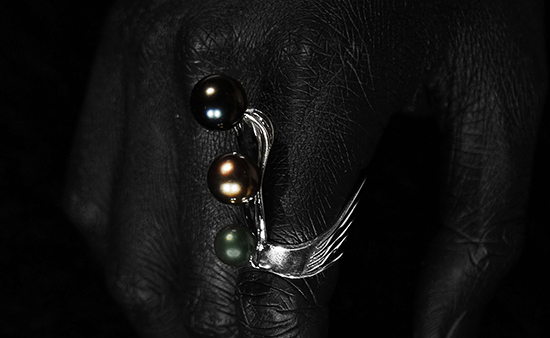
I have found that pearls as a precious material can magically make a piece of jewellery to be very elegant and feminine. I have not used pearls in a traditional way. I make the pearls roll and move in the piece, also because movement is a significant part in my collection.
Which designer or artist do you most admire?
Wallace Chan, Gustav Klimt, Jeanne Toussaint.
What’s next for you after CSM?
I will stay in London and start working,I haven’t decided which brand I am going to work with.
Who could you imagine wearing your jewellery?
Any elegant and mature ladies, such as Monica Bellucci, Charlize Theron, Angelina Jolie, Helen Miller or Sharon Stone.
What is it that makes a piece of jewellery a design classic?
Unique design, a special element and the meaning behind the jewellery.
REFLECTION - QINYING QUEENIE WANG
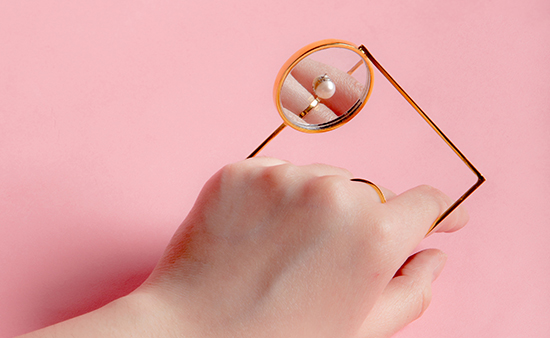
Tell us a little bit about yourself.
Born in China, I moved to the UK and began to study Fine Art in my A-level years. I specialised in jewellery design 4 years ago and I believe that all forms of art are interlinked and connected.
What was the inspiration for this collection?
Water reflections were my initial inspiration for the collection. Influenced by Evelie Mouila, I tried to explore the relationship between wearer and jewellery, and her photography got me to rethinking the meaning of “wearing”. Based on the concept of reflection, I mainly focused on mirror reflections.
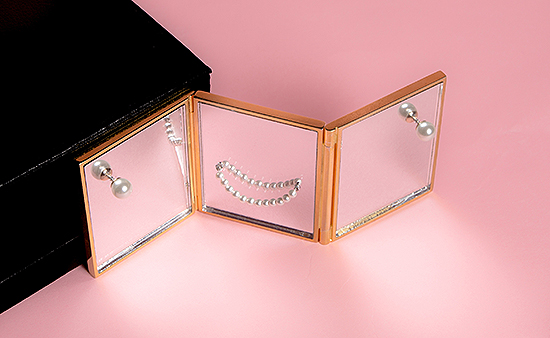
Women are always staring at the mirror; admiring their jewellery and themselves. My collection aims to enhance the luminosity of our own bodies and appreciate our own specialness.
What have you discovered about working with pearls?
To work with pearls was a new experience for me. Pearls are always giving us a feeling of being elegant and graceful. I was able to find many possibilities by mixing different materials with pearls.
Which designer or artist do you most admire?
Gijs Bakker’s works are always influencing me strongly.
What’s next for you after CSM?
I intend to pursue a Masters degree after CSM.
Who could you imagine wearing your jewellery?
The Minimalist. And women who have their own personal styles.
What is it that makes a piece of jewellery a design classic?
The one that could broke through time's boundaries, with a strong story or concept behind it.
WONDER OF NATURE - DANYA XIE
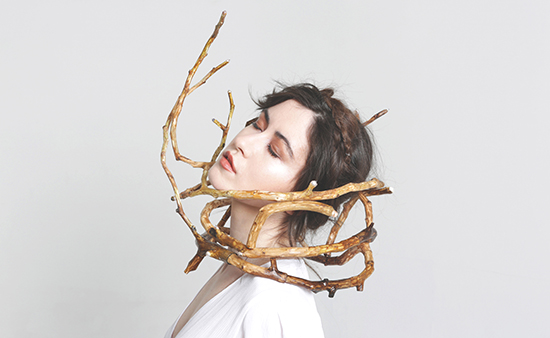
Tell us a little bit about yourself.
I’m a Chinese girl who likes collecting natural materials and using them into jewellery.
What was the inspiration for this collection?
I find my inspiration in nature. In my work I visualise the relationship between man and nature. I am fascinated especially by the human interference in nature; the traces that are left behind by taking care, organising or controlling nature.
This unpredictable power of life is for me a source of inspiration. This dialogue between control and freedom has become the general theme for my jewellery.
What have you discovered about working with pearls?
Pearls always give people a sense of the gentle, the delicate and the feminine, but I found pearls are actually a material with potential to be strong and powerful.
Which designer or artist do you most admire?
It’s hard to say who’s the most important, but Sam Tho Duong, Andy Goldsworthy, Henrique Oliveira did inspire me for this collection.
What’s next for you after CSM?
Natural materials will always be my inspiration for making this art jewellery.
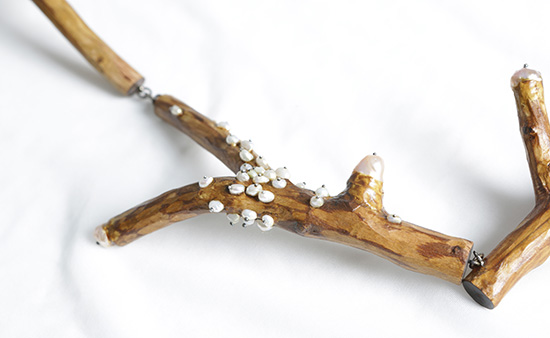
And pearls and wood are my favourite ones; I think I will keep working with them.
Who could you imagine wearing your jewellery?
The women who enjoy natural materials like I do.
What is it that makes a piece of jewellery a design classic?
The connotation, the story behind the piece and the refined finishing would make the jewellery classic.
View more of Danya's work here. -
Designing with Pearls at CSM 2015 - Part II
Designing with Pearls at CSM 2015 - Part II
Here we feature the second in a series of short interviews with designers from the Central Saint Martins Jewellery 2015 show and pearls at CSM, including in this article – Hye Ri Kim, Lucy Parker and Ellie Castillo Siu.
For the third year, we have been working with the students designers of the Central Saint Martins Jewellery Design course. We will be awarding a Winterson Prize to one of the students for ‘The Best Use of Pearls’ at Jewellery Awards Evening on 25th June.
Read about some of the other designers here in Part I and Part III of this series and the Winner of the Winterson Prize 2015.
MEMORY, ETERNITY & MOURNING - HYE RI KIM
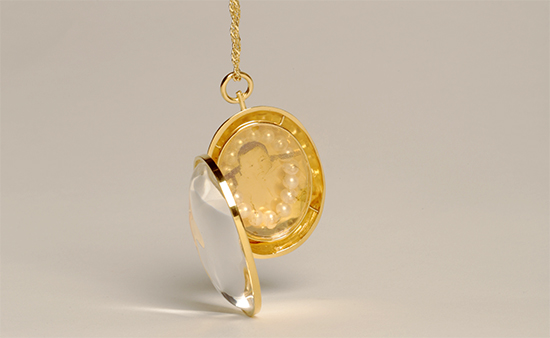
Tell us a little bit about yourself.
I was born and raised in Korea. I received a Bachelor's degree in Fine Art a few years ago. After graduating, I desired to make objects that can be worn on the body so I decided to study jewellery design at CSM.
What was the inspiration for this collection?
My collection is inspired from Victorian Mourning jewellery. The meaning of mourning jewellery is not only to keep the memory and commemorate the death of a loved one but also to remind the wearer of mortality. A locket is considered as a memory keepsakes and the belt/buckle motif represents eternity and memory forever. It also represents secure the bond of life between the deceased and the bereaved.
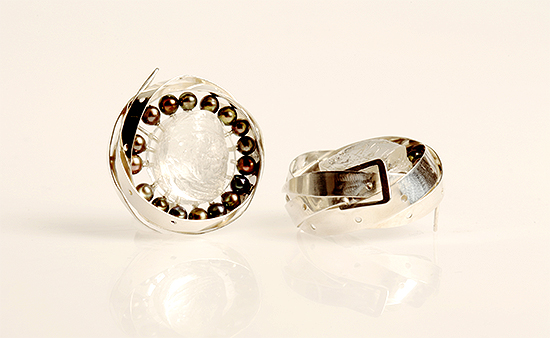
With these motives, in my collection I want to reinterpret mourning jewellery in a modern way.
What have you discovered about working with pearls?
As my inspiration is mourning jewellery, the pearl has been considered as tear drops that are perfect for this. Also the pearl has a very natural and traditional beauty that has been consistently loved over the years. Throughout the collection, I have combined traditional design and material with modern techniques.
Which designer or artist do you most admire?
I love David Hockney’s work. Particularly, his photo collages give me lots of inspiration.
What’s next for you after CSM?
During my studies at CSM, I realised that I would like to research more about jewellery, so I decide to study further in London. But my ultimate goal is having my own brand.
Who could you imagine wearing your jewellery?
I expect everyone should love my pieces. But this collection, I could imagine being worn by people who keep their memory in a small piece of jewellery.
What is it that makes a piece of jewellery a design classic?
In my opinion, time and personality makes jewellery classic.
CLASSY - LUCY PARKER
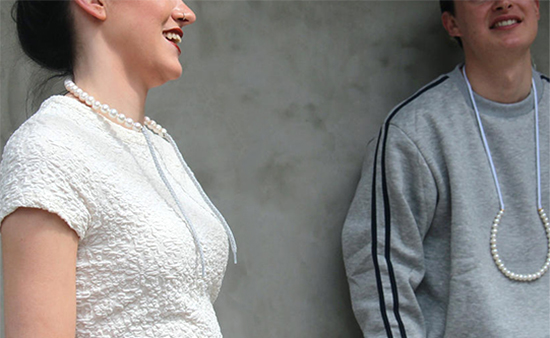
Tell us a little bit about yourself.
Studying at Central Saint Martins for the past 3 years has given me the chance to discover the type of jewellery designer I am and where my interests lay.
I have always been curious as to why there are stereotypes, either through the way someone behaves or what they choose to wear, and how this can put someone into a group, similarly how can an object or piece of jewellery become a symbol or an icon.
I like to challenge these stereotypes and beliefs through my jewellery. Using humour or romance as a guise to transform a stigma around the topic in hand.
What was the inspiration for this collection?
My concept stemmed from my fascination with the class system in Britain. I started to notice the many different types of people living in the same place, and the subtle harmony amongst these people, regardless of class and status.
Most of my interest lay in the working class and the ‘underclass’, which is the unemployed part of the population also labelled as ‘Chavs’. By watching documentaries and films such as; Fish Tank, Skint, All in the Best Possible Taste and reading different texts and theories for example the book ‘Chavs’ by Owen Jones, I noticed a romanticism to this class, the sweet, sentimental side to the class that are still mourning the loss of industry in Britain.
The empty, desolate feelings they have replicate those of the working class when Thatcher was in power, feelings that being part of the working class wasn’t good enough, as if history is repeating itself.
What have you discovered about working with pearls?
I used pearls as a medium to express the feeling of preciousness, luxury and wealth that is seen amongst the middle and upper class. I discovered what pearls mean symbolically, and what they can say about the person wearing them and how certain types of pearl jewellery have become icons.
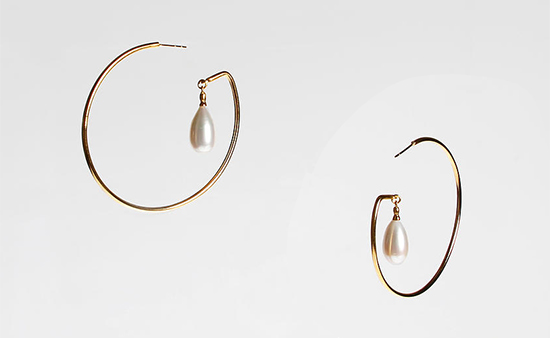
For example I used the symbol of the hoodie and the hoop earring to interrupt the classic pearl necklace or drop pearl earring, to mirror the harmony I noticed amongst different people living in the same place.
Which designer or artist do you most admire?
Grayson Perry.
What’s next for you after CSM?
I would like to work for an established jewellery designer and eventually become an independent jewellery designer and potentially teach jewellery to university level students or higher.
Who could you imagine wearing your jewellery?
Most of my pieces are unisex, they are all quite different from one another. The Hood is more of a statement or catwalk piece, or maybe used as part of a photoshoot for an editorial. The pearl chokers and earrings are more versatile and wearable.
I wouldn’t like to restrict who could wear my jewellery, but I would imagine someone who is either a creative or someone looking to make a statement with their jewellery, a fashion blogger or stylist with a unique style.
What is it that makes a piece of jewellery a design classic?
I think it would be time, it would mean that the piece of jewellery is still being produced or worn 20 years later and maybe it is redesigned many times with different variations of stones or materials but the shape or idea remains the same.
View more of Lucy's work here.
SOFT DIAMONDS - ELLIE CASTILLO SIU
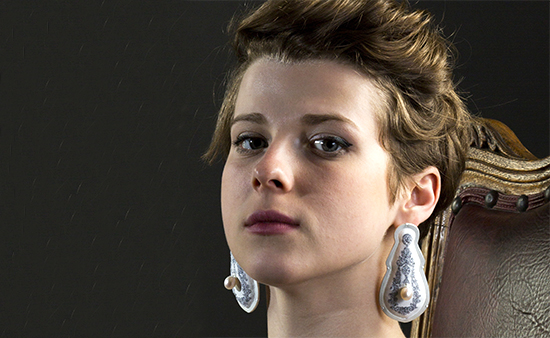
Tell us a little bit about yourself.
Despite the often polished and refined tone that is in the final outcome of my work, the combination of materials that I use are somewhat unconventional.
I really enjoy the transforming of materials from something non-precious to precise. Influenced by my Chinese and international background, I tend to create pieces that merges different cultures together.
What was the inspiration for this collection?
One of the contemporary jewellery piece that most influenced my collection was Otto Künzli’s ‘Gold Makes Blind’. The piece questions the way we associate value to substance like gold by concealing the ‘precious’ material underneath a blanket of the ‘non-precious’ rubber.
Fundamentally, Künzli is setting two kinds of value that opposes each other. One being the value of ‘precious’ materials, which encompasses conventional jewellery, and another being the value of artistic expression and the conceptual idea behind the work, which underpins the value of contemporary jewellery. In turns, one can no longer judge which is the more important or precious.
I was very inspired by his way of questioning material value and the value of artistic expression, whether one is more important than the other. This in turns made me question our perceived value of materials which ultimately started this collection.
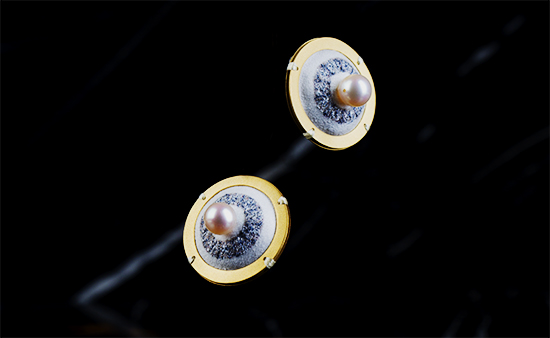
I intend to juxtapose ‘precious’ and ‘non-precious’ materials in the hope to invert their ‘material hierarchy’. So that materials that are regarded as non-precious can be put together with precious materials as equals. So that ‘precious’ materials like silver and ‘non-precious’ materials like threads can be valued solely by their aesthetic qualities and not their material value. I decided to use needle and threads to embroider Queen Elizabeth II's jewellery, as they epitomise the apex of luxury jewellery.
What have you discovered about working with pearls?
Using pearls made me realize the elegant and lustrous quality that the gem adds to my pieces. The addition of pearls not only adds depth and beauty to my piece, it also lifts my 2 dimensional embroidery to life, by juxtaposing the 2 dimensional embroidery with the 3 dimensional pearls.
Which designer or artist do you most admire?
One of my all time favorite designer is Shaun Leane, I really admire his way of transforming the female silhouette into something fiery and untouchable. The sharp refined edges with the compliment of pearls in his work really intrigues me. In addition his use of unconventional material with precious material is also one of the reasons I was attracted to his work.
What’s next for you after CSM?
I have been awarded a G.I.A scholarship to study a ‘Graduate Geologist Course’ in Hong Kong for six months. Upon receiving my bachelor’s degree I will start my G.I.A course immediately.
Who could you imagine wearing your jewellery?
As I mentioned, in the beginning of my collection I always imagined for Her Majesty The Queen to wear my jewellery, as the pieces are indeed an imitation of her personal jewellery in embroidery. All of my pieces are, embroidery versions of her actual jewellery pieces.
What is it that makes a piece of jewellery a design classic?
I believe in order for a piece to be considered as a classic, it will definitely involve craftsmanship, quality of material, display a certain elegant aesthetic and be exceptional of its kind.
-
Designing with Pearls at CSM 2015 - Part I
Designing with Pearls at CSM 2015 - Part I
For the third year, we have been working with Central Saint Martins, the leading art and design centre based in London.
Our collaboration gives the student designers an opportunity to experience designing with pearls at CSM for their final year work, which is showcased at a sparkling Jewellery Awards Evening on 25th June. We will be awarding our Winterson Prize to one of the students for ‘The Best Use of Pearls’.
The designs are also open to the public at CSM during June 24-28th.
Here we feature the first in a series of short interviews with designers from the CSM Jewellery 2015 show, including in this article - Evangeline Armstrong, Hoonik Chang and Soo Hyun Jeong.
Read about some of the other designers here in Part II and Part III of this series and the Winner of the Winterson Prize 2015.
THE DAILY GRIND - EVANGELINE ARMSTRONG
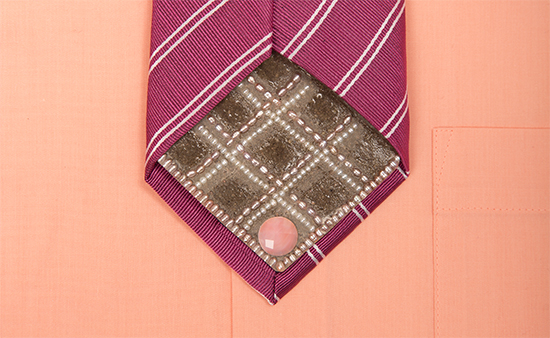
Tell us a little bit about yourself.
I have never viewed jewellery in a conventional sense - I rarely wear jewellery and haven’t got my ears pierced!. It was introduced to me as ‘3d design on the body’ or body-sculpture during the CSM Foundation. Through the duration of the BA course, I have become passionate about the subcultures that do not adorn themselves and why this is so. Starting with this project, I aim to inject fun and expression into these areas.
What was the inspiration for this collection?
While caught in The City at Bank during rush hour, the prominent grey colour of the palette that prevailed struck my attention: the grey faces in grey suits, set against the grey concrete of buildings and pavements, against grey skies. Uniformity is discernibly the nature of this environment as this tailored army marched the streets.
The starting point from this collection grew from seeing a man sitting down at a café, flashing brightly coloured socks as he did, breaking the monotone monotony.
My aim is to make a collection of Secret Jewellery for the City Businessman by working within the strict codes of dress in the business environment to eject fun and expression where adornment appears limited.
What have you discovered about working with pearls?
How well they go with concrete! I think they have such a beautiful material juxtaposition. I have been discovering new ways of setting them with in a fluid mix in plasticine negative. I have favored them in a lot of projects while at Saint Martins, and think they are very versatile and non-synthetic.
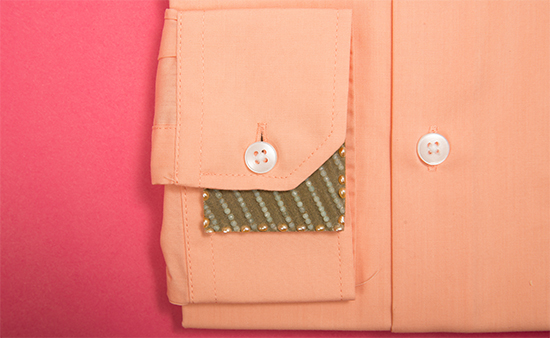
Having quite graphic designs, the subjectivity of a pearl's shape by being a natural object really adds a new dimension of sensitivity to my pieces.
Which designer or artist do you most admire?
Depends on what day it is! There are so many niches for style, mood, sensitivity and skill. For this project, tailors fascinated me: it is an age-old tradition yet has been re-invented time after time- take McQueen for example. I was greatly inspired by the BA LCF tailoring students that I collaborated with: Zoe Yates had wit, skill and sensitively novel designs that I’m sure will go far.
What’s next for you after CSM?
I intend to keep pushing the ‘blind spots’ in Jewellery design. Working with people and contacts gained over the years has set me up with a few fun projects that I would love to do.
I am mostly open to learning and enjoying creativity. I have a plan to balance my work life/London living with enough time to focus on my creative work. It would be the most wonderful bonus to make a living out of what I Love but essentially it is the doing it that is of real reward. This I always hope to maintain.
Who could you imagine wearing your jewellery?
Someone who could do with more smiles in their 9-5.
What is it that makes a piece of jewellery a design classic?
Again, looking for the ‘blind spots’ in design, to innovate ways of wearing, fabricating or making the Jewellery. As much as there is aesthetic beauty, I find that what attracts me is something emotive or provoking: making you think further than ‘oh that’s nice.’
IMAGINARY PRINCESS OF KOREA - HOONIK CHANG
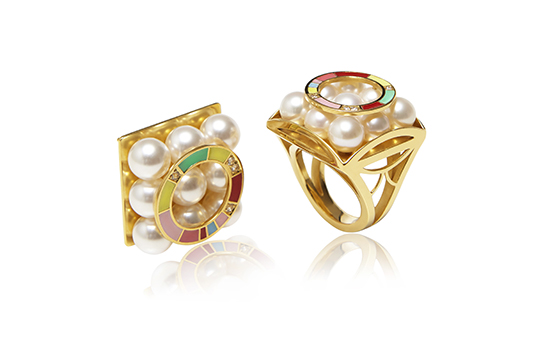
Tell us a little bit about yourself.
I am a hardworking designer who is energetic, flexible and open for any opportunities to achieve development and improvement.
I strongly believe that jewellery is a key element that has completed the fashion style throughout any historical period.
What was the inspiration for this collection?
My collection is designed for an imaginary Korean princess living in modern day Korea. Royal objects have a very rich, delicate and elaborate feeling so I have chosen an extensive use of materials and colours in the design and construction of this collection.
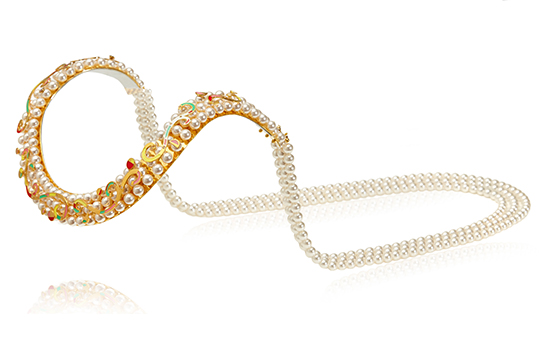
The collection is a harmonized mix of Korean tradition with modern luxury fashion designed for my muse.
What have you discovered about working with pearls?
I have discovered that pearls could be interestingly used with their drill holes. Using the holes could create any form, any shape with any materials.
Furthermore, pearls generally give jewellery design a very classic and colourfully luxurious look.
Which designer or artist do you most admire?
Solange Azagury-Patridge
What’s next for you after CSM?
I am going Geneva to do my internship in September. Then, I would like to work in Paris or other European countries since there are various opportunities within great luxury fashion and jewellery companies there.
Who could you imagine wearing your jewellery?
A group that is fashionable, smart, polite, feminine and luxurious.
What is it that makes a piece of jewellery a design classic?
In my opinion, the form and material of jewellery influences a design classic.
FACE & PEARLS - SOOHYUN JEONG
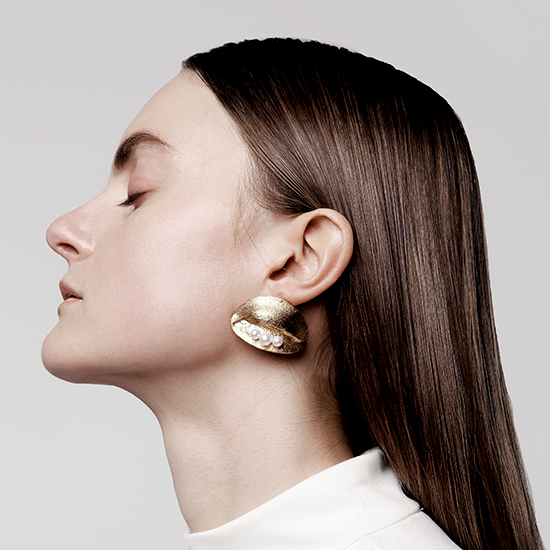
Tell us a little bit about yourself.
I was born in South Korea and came to London in 2011 to study art and design.
What was the inspiration for this collection?
I started my collection by considering the issue of plastic surgery in South Korea. I wanted to talk about false desire of the beauty that people have through my collection!
What have you discovered about working with pearls?
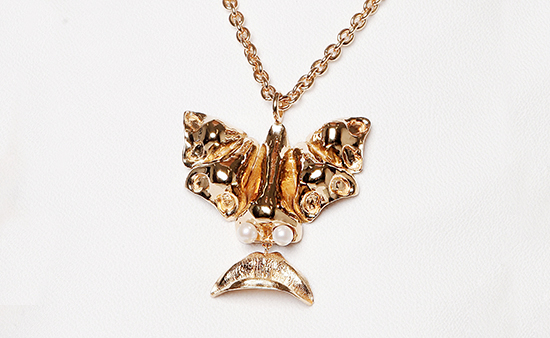
Pearls are attractive for their pure beauty, brilliant colour and how they are made. They are such an easy material to work with compared to other precious gems!
Which designer or artist do you most admire?
The designer that I admire the most is Delfina Delettrez. Her unusual concept has humour and she transfers this into jewellery with style.
What’s next for you after CSM?
I want to experience how the real world of jewellery is and to find out more about my own style and strong points of design.
Who could you imagine wearing your jewellery?
I can imagine that people, who are looking for jewellery that has something new and is still wearable and ornamental, would wear my jewellery.
What is it that makes a piece of jewellery a design classic?
Considering how to make wearer feel comfortable and to have pride in the jewellery is the way to make a piece of jewellery a design classic!
View more of Soohyun's work here. -
Savage Beauty: Alexander McQueen
Savage Beauty: Alexander McQueen
Two current exhibitions in London reverentially showcase the work and career of Alexander McQueen (1969-2010), one of fashion's most innovative designers.
Alexander McQueen: Savage Beauty at the V&A and Nick Waplington/Alexander McQueen: Working Process at Tate Britain offer different perspectives on the late designer's talent, influences and processes.
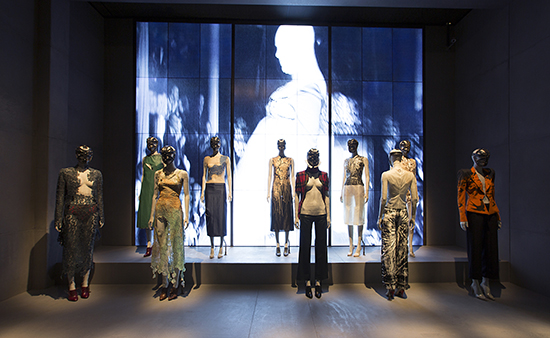
First shown in New York and extended here at the V&A, Savage Beauty is a wonder, a series of rooms filled with gothic fantasy, tribal identity, romantic inspiration and a passion for nature.
The exhibition is structured as a narrative of different collections, starting with McQueen's tailored and revealing bumster trousers, his 1995 Highland Rape collection, 1996's Hunger and the exhilarating Horn of Plenty from 2009.
The exhibition finale recreates 2010's Plato's Atlantis collection, a futuristic and thrilling fusion of technology and fashion, complete with its famous Armadillo shoes.
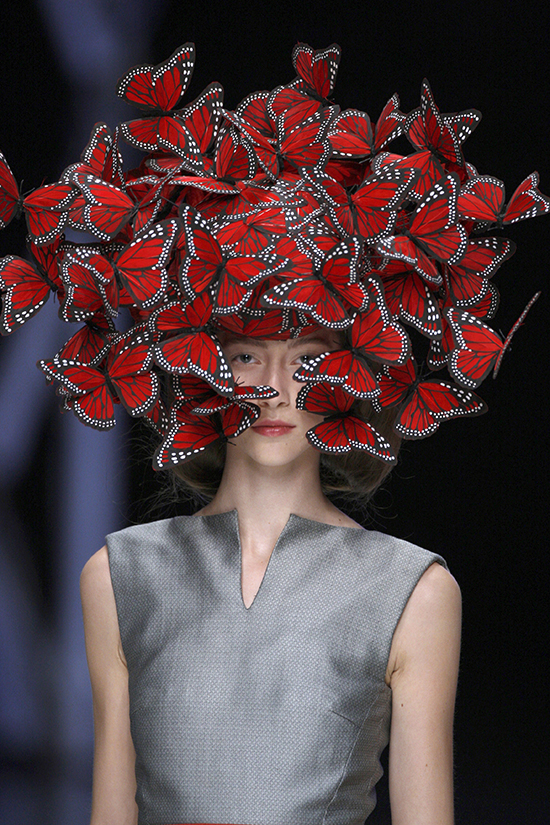
Deeper within the exhibition is the dramatically macabre Cabinet of Curiosities.
This centrepiece room is a spectacular double-height gallery showing archive video footage from McQueen's catwalk shows and accessories, including a butterfly headdress of hand-painted turkey feathers (pictured above) by milliner Philip Treacey.
Jewellers Sarah Harmarnee and Shaun Leane feature prominently. Leane was a long-time collaborator of McQueen, having first met at Central Saint Martins in London.
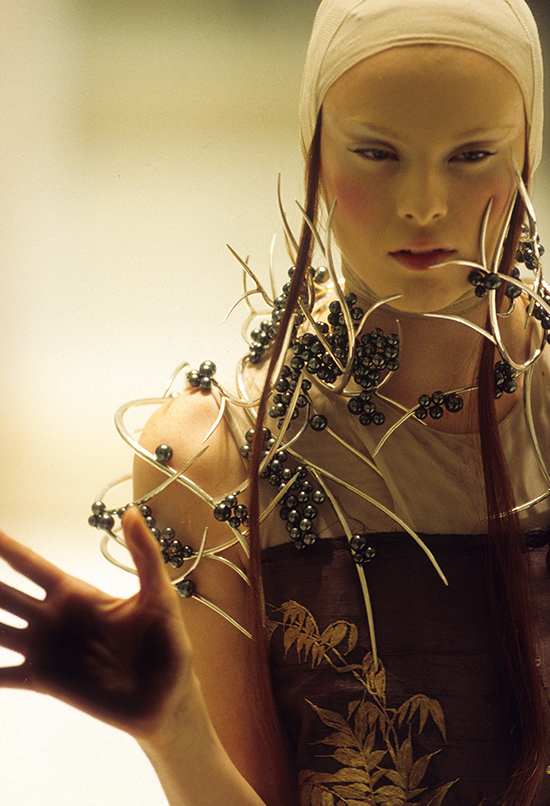
Leane's distinctive aesthetic is recognisable in the pieces shown in the Cabinet - a Tusk earring for McQueen's Hunger S/S 1996 collection and this neckpiece (pictured above) with silver thorns and grey Tahitian pearls from 2001.
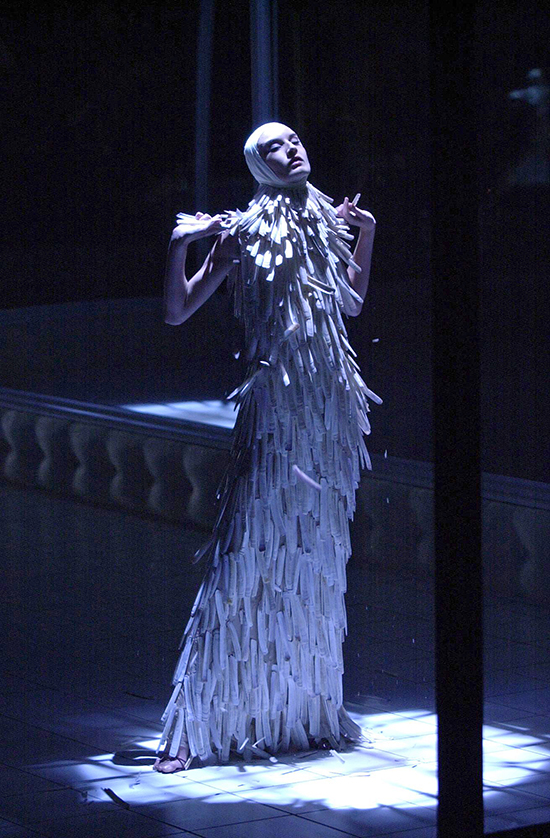
Performance and footage from McQueen's shows feature throughout the exhibition, with one highlight being a hologram of Kate Moss floating eerily in the finale to the 2006 Widows of Culloden show.
The staging of the exhibition has been beautifully done with many pieces such as the razor clam dress (pictured above), arguably being close to works of art themselves.
A must-see retrospective, this exhibition gives a glimpse of the extraordinary and creative talent at work.
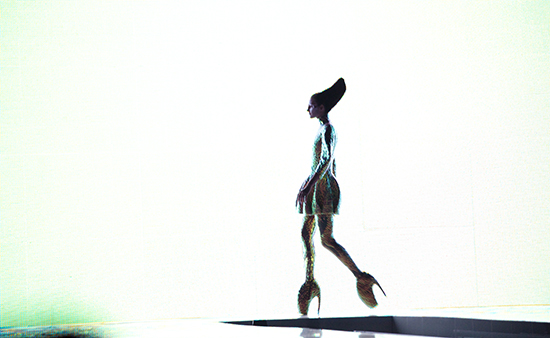
On McQueen's right arm was a tattoo, with words from A Midsummer Night's Dream 'Love looks not with the eyes, but with the mind'.
If you are left wanting more, it would be to understand and hear from McQueen himself.
Savage Beauty is open at the V&A, London until 2 August 2015. -
Bright Young Gems at IJL 2014
Bright Young Gems at IJL 2014
Victorian splendour met some Bright Young Gems last week and London sparkled!
Well done too to the organisers of the International Jewellery London show (IJL) this year, which for the first time was hosted in the dramatic, galleried setting of Olympia in London.
We visited on the first day of the show. This fabulous new venue for IJL is light and spacious, offering a perfect environment to explore the latest designs and collections of outstanding jewels.
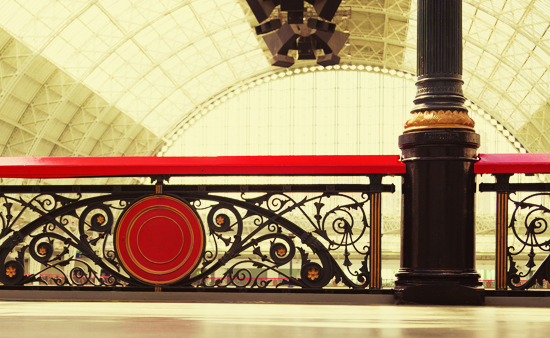
For the 9th year now, the Bright Young Gems initiative celebrates the work of some of our future leading jewellery designers. Nominated by a prestigious panel of editors and jewellery leaders, the finalists this year are Fortuna Weeks, Joanna Bury, Jessie Seo, Youjin Nam and Kiki Tang.
There was much to admire, with their original designs experimenting with materials including wood, silk, pearls and enamel, with forms ranging from baroque to the geometrical.
KickStart, sponsored by IJL and the British Jewellers’ Association (BJA), also supports ten flourishing UK designers in helping them to exhibit their work at IJL.
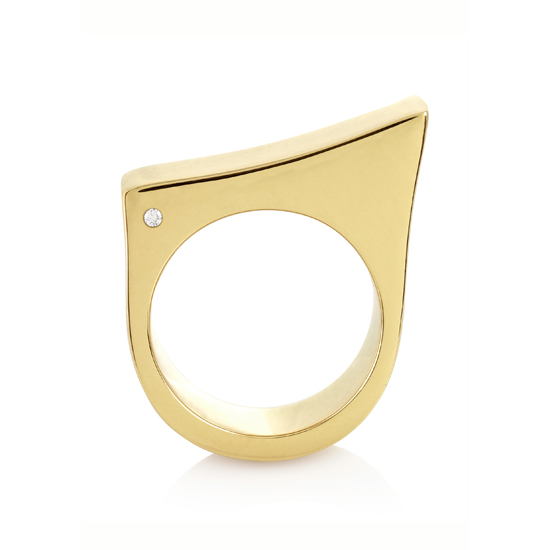
Amongst these talented designers, we loved the work of Iwona Majdan in particular. Her jewellery is bold, with clean design lines and an elegant edgy style.
With no doubt, this was one of the most successful IJLs in recent years and a wonderful opportunity for designers to reveal and introduce their latest collections.
-
Felicia Swartling: Winterson Prize 2014
Felicia Swartling: Winterson Prize 2014
We are delighted to announce that the winner of the Winterson Prize for Best Use of Pearls this year is Felicia Swartling, showcasing a collection that combined imaginative sculptural elements with the freeform shapes of baroque pearls.
The CSM Jewellery Degree Show Awards took place on Thursday 19th June at Central Saint Martins. Each year this exclusive awards ceremony celebrates the new and exciting creations submitted by graduates of the influential London arts institute.
And this year’s candidates certainly did not disappoint when it came to innovative and inspired jewellery design.
CSM Programme Director Caroline Broadhead said: 'The final year at CSM is an exciting and demanding one and with such a high standard of work this year, we warmly congratulate Felicia on her success and well-deserved award.'
This year’s judging panel comprised Winterson Director Andrew Fraser, Caroline Broadhead, Programme Director at CSM, Maia Adams, Director and Founder at Adorn Insight, and British jewellery designer, Alice Cicolini, herself an MA graduate of Central Saint Martins.
The judges also commended Ruiyin Lin for work that drew parallels between how pearls take their form and modern materials that are constructed using 3D printing.
Commenting on the award, Winterson Director, Andrew Fraser said: ‘Felicia's work showed a well-judged appreciation of how each pearl could become an integral part of each piece, as well as being impressively accomplished at a technical level. We are delighted to award Felicia this year's Winterson Prize.'
Read more about Felicia's work in our interview here.
-
Central Saint Martins Jewellery 2014 - IV
Central Saint Martins Jewellery 2014 - IV
Here we feature the final part in our series of short interviews with designers from the Central Saint Martins Jewellery 2014 show, including in this article – Sylvia Zhang, Tresy Liaunardy, Vicky Lew, Yerin Jeon and Ying Lola Lou.
For the second year, we have been working with the students designers of the Central Saint Martins Jewellery Design course. We will be awarding a Winterson Prize to one of the students for 'The Best Use of Pearls' at Jewellery Awards Evening on 19th June.
Read about some of the other designers in Part I, Part II and Part III of our interviews here. Discover the Winner of the Winterson Prize 2014 here.
SYLVIA ZHANG
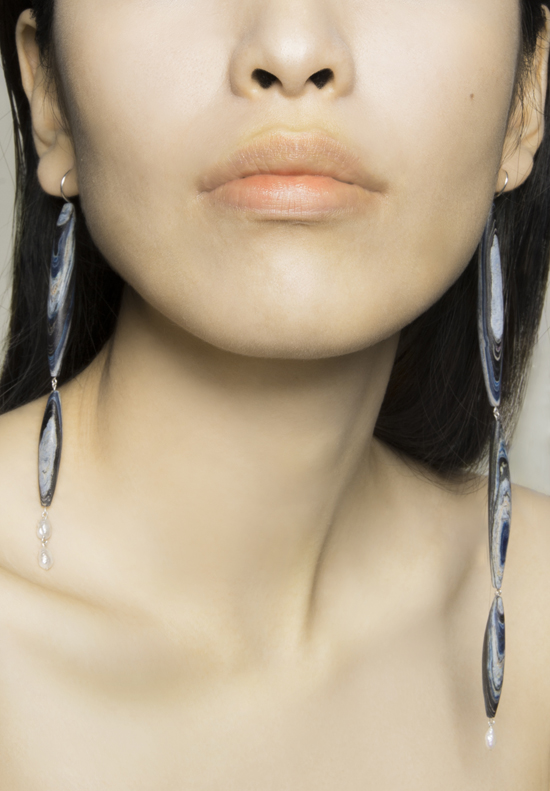
Tell us a little bit about yourself.
My name is Sylvia Zhang.
What was the inspiration for this collection?
The aesthetic of Taoism’s simplicity and the philosophy of worshipping nature.
What have you discovered about working with pearls?
Pearls have great possibilities and can work really well with different concepts.
What’s next for you after CSM?
I will be pursuing higher academic qualifications.
Which designer or artist do you most admire?
David Watkins.
Name one jewellery toolbox essential that you can’t live without.
My files in different grades.
Name your favourite place for design in London.
Tate Modern.
TRESY LIAUNARDY
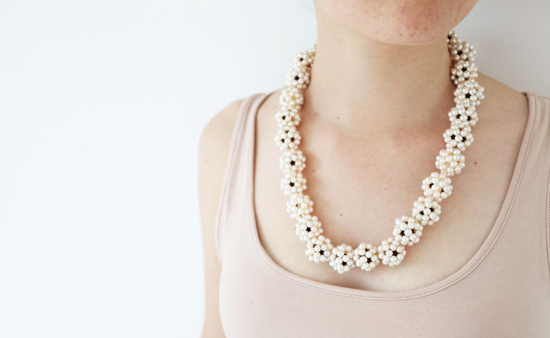
Tell us a little bit about yourself.
I am from Indonesia, I was introduced to the world of jewellery by my mother, because of her profession. I believe in handmade jewellery and the journey of making the piece itself.
What was the inspiration for this collection?
I was inspired by United Kingdom itself, which is a beautiful country with rich backgrounds and stories.
What have you discovered about working with pearls?
I have discovered that pearls are very versatile, the rich colour and lustre can be combined with any material.
What’s next for you after CSM?
I would like to learn more about fine jewellery making.
Which designer or artist do you most admire?
JAR: Joel A. Rosenthal.
Name one jewellery toolbox essential that you can’t live without.
My pin vice.
VICKY LEW
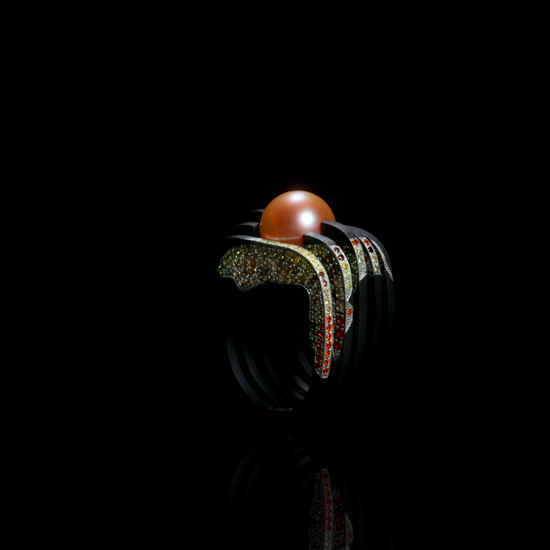
Tell us a little bit about yourself.
I am a Malaysian-born and bred girl. I grew up surrounded by shoes – Dad's a shoe designer and Mum's very lucky!
I initially planned to pursue a shoe design course but decided on jewellery instead (much to my Dad's amusement), just because I wanted to work on different parts of the body rather than just on the feet.
What was the inspiration for this collection?
My collection Flight was inspired by a photo I took of a bird in Hyde Park. It was spreading its wings before it flew away. It's such a lovely transient moment and I like to preserve such moment in pieces of jewellery.
What have you discovered about working with pearls?
The pearl has a luminescence that is unlike other gem, never failing to add a touch of luxury to any piece. A t-shirt will instantly look regal and elegant with pearls sewn into them.
What’s next for you after CSM?
Having my own studio would be nice.
Who could you imagine wearing your jewellery?
I'd like to see Tilda Swinton wearing my pieces.
What is it that makes a piece of jewellery a design classic?
A memorable one.
What is your most treasured piece of jewellery?
My gold baby ring, which I now wear as a pinky ring.
Which designer or artist do you most admire?
Gijs Bakker for his interpretation of jewellery, always unexpected and very clever.
Name one jewellery toolbox essential that you can’t live without.
My handy Dremel torch, it's also good for the occasional creme brulee.
Name your favourite place for design in London.
The Victoria and Albert Museum, I get inspired by different things each time I visit.
What’s your motto?
Perseverance is the key to success.
YERIN JEON
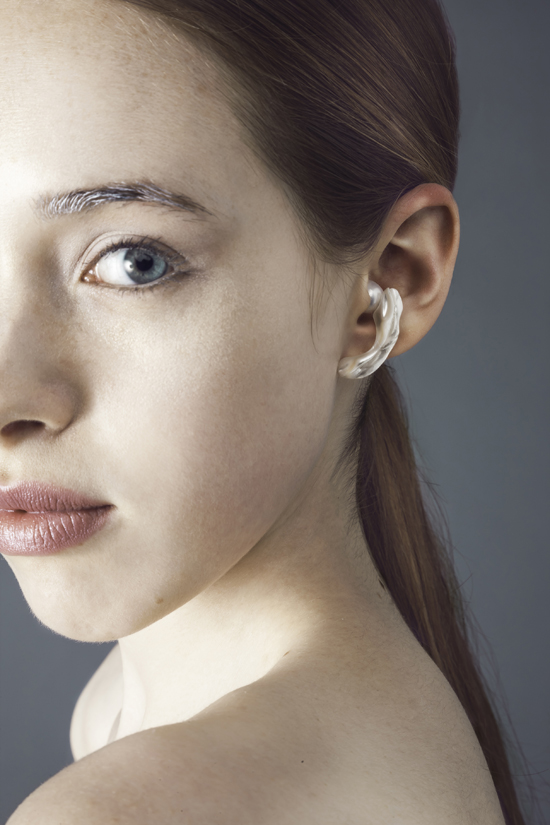
Tell us a little bit about yourself.
My name is Yerin Jeon, I come from South Korea. I studied fine arts in Germany and then came to London to study jewellery design at Central Saint Martins. I am a designer and a creative.
What was the inspiration for this collection?
Attempt to visualize the invisible. Especially the sound of silence, which is interpreted internally and externally in this collection.
Wearing the piece, from the other side, people can visually trace the flowing lines of resonance around body.
What have you discovered about working with pearls?
I researched more about how pearls are created and chose to focus on their shell, where they are formed.
I also looked at how pearls can function as a medium to allow sound to remain trapped within them. Furthermore, I was surprised to find out that when pearls are worn as earrings, they give a soft and comforting feeling.
What’s next for you after CSM?
I would perhaps like to work for a fashion brand because I am interested in how they accentuate the properties of textiles and the beauty of objects around us.
Which designer or artist do you most admire?
Francis Alÿs.
What’s your motto?
You create your opportunities by asking for them (Patty Hansen).
YING LOLA LOU
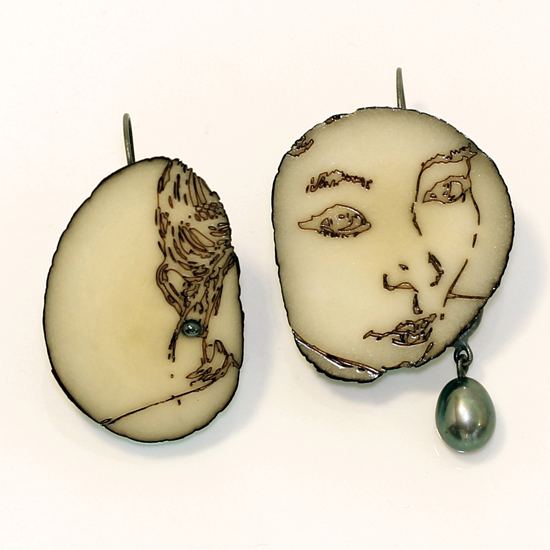
Tell us a little bit about yourself.
My name is Ying Lola Lou, born and raised in China. I am interested in observing the people, living things or anything that might catch my eye.
What was the inspiration for this collection?
The idea of this project is to turn my drawings into jewellery or wearable accessory pieces. This is my own way of capturing my memories.
The drawings are portraits of my friends, of hands holding or picking up a stone. As most of the pieces (with drawings on them) are quite flat, I am playing with the components, to add some other element such as branches cast from metal, pearls or wire frames that continue the drawing.
What have you discovered about working with pearls?
Pearls are not as fragile as I imagined they would be. And you can’t glue pearls onto the silk thread because the silk thread breaks apart after the glue dried.
What’s next for you after CSM?
I would like to learn about ceramics.
Which designer or artist do you most admire?
Salvador Dali.
Name one jewellery toolbox essential that you can’t live without.
My jewellery files.
-
Central Saint Martins Jewellery 2014 - III
Central Saint Martins Jewellery 2014 - III
Here we feature the third in a four part series of short interviews with designers from the Central Saint Martins Jewellery 2014 show, including in this article – Raven Tuson, Robyn Hole, Ruiyin Lin and Shirley Li.
For the second year, we have been working with the students designers of the Central Saint Martins Jewellery Design course. We will be awarding a Winterson Prize to one of the students for 'The Best Use of Pearls' at Jewellery Awards Evening on 19th June.
Read about some of the other designers in Part I, Part II and Part IV of our interviews here. Discover the Winner of the Winterson Prize 2014 here.
RAVEN TUSON
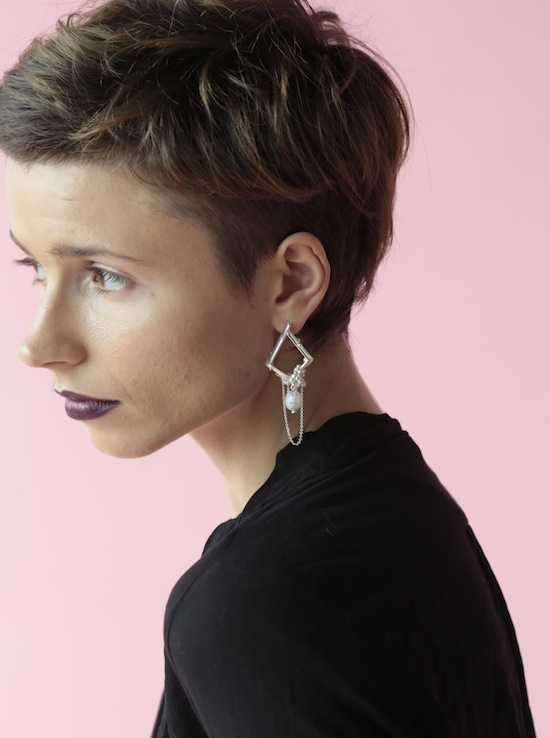
Tell us a little bit about yourself
I am always bursting with ideas and like to express these by trying out new materials and methods. I enjoy visiting museums and being creative by capturing inspiration from sketching and photography.
What was the inspiration for this collection?
The focus of this collection is the lifecycle of architectural structures and how, over time, they are transformed by the natural world. The collection aims to portray the stages of transition from cradle to grave, with the pieces representing a milestone in the buildings lifecycle.
Each stage is expressed through a varied use of materials with delicate lines of silver wire and chain representing the architectural structure and fine silver granules and a mixture of stones appearing as natural growths on the pieces.
What have you discovered about working with pearls?
Using pearls was a great way of introducing my work to using real life grown formations and offered my jewellery a natural element.
What’s next for you after CSM?
I intend to continue with designing and making, creating many more collections and building my own business.
What is your most treasured piece of jewellery?
The brooch as it collects all my significant elements in one piece.
Name one jewellery toolbox essential that you can’t live without?
My files as it allow me to create perfect angles for geometric effects.
ROBYN HOLE
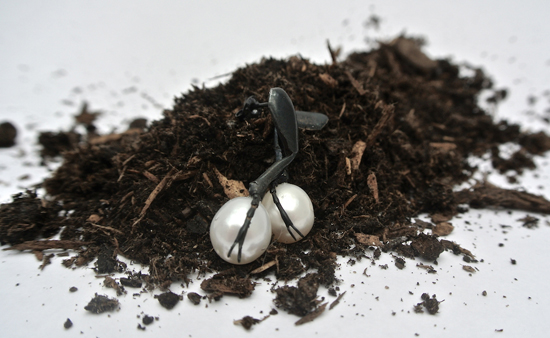
Tell us a little bit about yourself.
I have been designing /making jewellery for the past 3 years and I enjoy experimenting with materials and ideas. Finding a good concept keeps me interested and always thinking.
What was the inspiration for this collection?
The metamorphosis of a beetle was the inspiration for this collection.
What have you discovered about working with pearls?
I have learnt a lot about pearls during this project and I have learnt that silicone can be used as a vehicle to enhance small pearls and make them look bigger. I have also learnt that the lustre of the pearls is very important.
What’s next for you after CSM?
After CSM I would like to create my own business selling jewellery, I would like to explore further the use of pearls and silicone.
Which designer or artist do you most admire?
Vivienne Westwood, because she pushes boundaries more than most.
What’s your motto?
Anything is possible and everything happens for a reason.
RUIYIN LIN
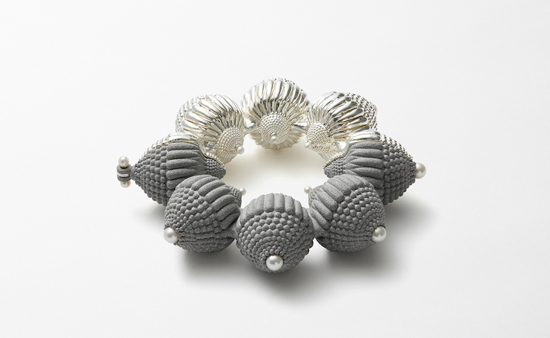
Tell us a little bit about yourself.
I am drawn to the aesthetics of the past as a way of preserving our memories and I adore the new with its unknown future.
What was the inspiration for this collection?
I wanted to create a collection that is both a tribute to the past and a prelude to the future, to explore our intuitive comfort of the familiar by taking traditional forms and subverting them with contemporary attitude and techniques.
What have you discovered about working with pearls?
Pearls are so hardy it sometimes still surprises me. I’m in love with how pearls are formed.
Mixing modern materials with pearls allow me to create a bridge between the processes of construction. Layers of nacre form pearls, and 3D printing is a process that is likewise built in layers. I hope to question the perceived preciousness of these materials and their authenticity.
What’s next for you after CSM?
I’m hoping to set up a jewellery and furniture studio.
Name one jewellery toolbox essential that you can’t live without.
My hands.
What’s your motto?
Stay hungry, stay foolish. – Steve Jobs
SHIRLEY LI
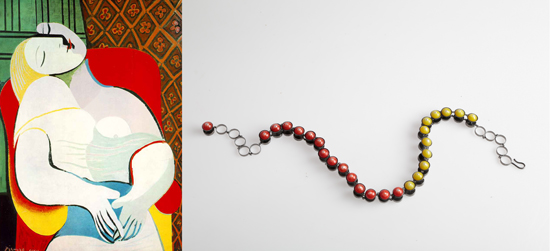
Tell us a little bit about yourself.
My name is Shirley Li. I am a jewellery design student at CSM, sick with design but I love art.
What was the inspiration for this collection?
The collection inspired by jewellery in famous oil paintings. I am trying to remake them and redefine their value.
What have you discovered about working with pearls?
It is a material that has lots of possibilities for use. Especially in my collection I made fake pearls with resin and wood. Mixing pearl powder in paints and using that to paint a new fake pearl. It is a process of deconstruction that redefines the value of pearl.
What is it that makes a piece of jewellery a design classic?
Full of designer’s love, a look that is simple outside and unique inside.
Name your favourite place for design in London.
No doubt, it is Central Saint Martins.
-
Central Saint Martins Jewellery 2014 - II
Central Saint Martins Jewellery 2014 - II
Here we feature the second in a four part series of short interviews with designers from the Central Saint Martins Jewellery 2014 show, including in this article – Gianna Pak Yung Chan, Ioanna Souflia, Jessie Seo and Junko Kurihara.
For the second year, we have been working with the students designers of the Central Saint Martins Jewellery Design course. We will be awarding a Winterson Prize to one of the students for 'The Best Use of Pearls' at Jewellery Awards Evening on 19th June.
Read about some of the other designers in Part I, Part III and Part IV of our interviews here. Discover the Winner of the Winterson Prize 2014 here.
GIANNA PAK YUNG CHAN
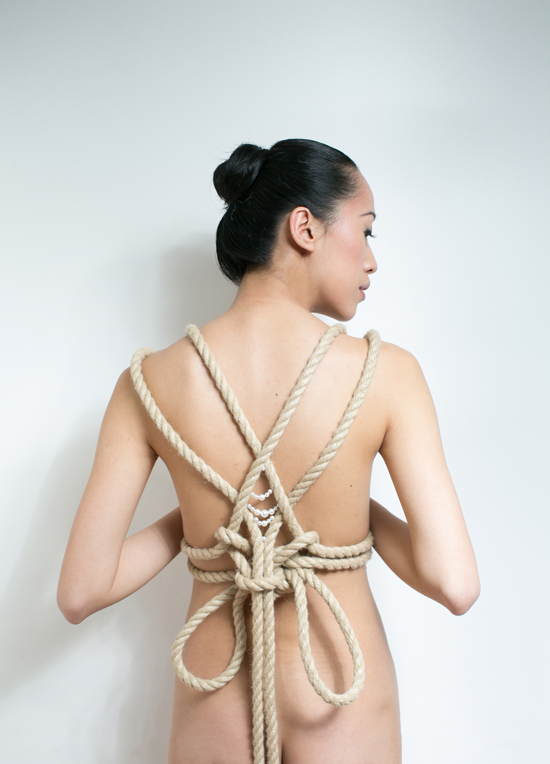
Tell us a little bit about yourself.
My name is Gianna Chan. I enjoy working with pearls and combine them with different types of material to explore new possibilities.
What was the inspiration for this collection?
In my final collection, I mainly use rope to play with the line and knots. The inspiration of my collection is from Japanese Bondage. Japanese bondage involves the interaction between ropes and knots on body to emphasis the body shape of female.
What have you discovered about working with pearls?
The uniqueness of each pearl brings out the differences of individual jewellery. This uniqueness can be differentiated by size, shape and texture etc. Each pearl may lend its character to the design with different settings, like twisting pearls strings to the knots. The roughness of rope and the smoothness of a pearl creates an interesting combination.
What is it that makes a piece of jewellery a design classic?
Historically, there are many paintings that included pearl jewellery. Photographs of Louise Brookes with simple long string of pearls shows an elegance of women that is memorable.
Classic design in jewellery often comes from the combination of using traditional technique with creativity. In my collection, the traditional way of stringing pearls with new expression in rope shows feminine and elegance in a classic style.
What is your most treasured piece of jewellery?
My parents gave me a jade pendant after my birth.
Name one jewellery toolbox essential that you can’t live without.
My hands! Tools are the integrated version of my hands.
IOANNA SOUFLIA
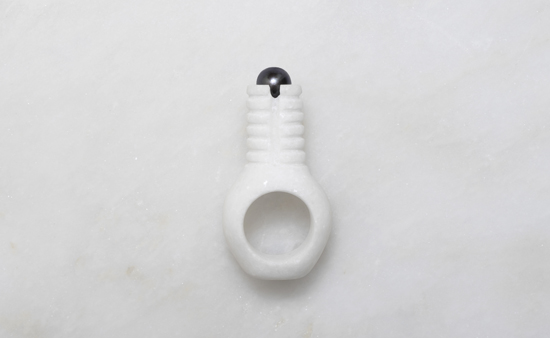
Tell us a little bit about yourself.
I am former law graduate who decided to challenge herself and enter the creative world through jewellery. I am amazed by the infinite possibilities of jewellery design and drawn to the challenge of expressing one self through such an object.
What was the inspiration for this collection?
The starting points for this collection were my contrasting fields of studies: law and jewellery. Contrasting elements; linear patterns and sculptural forms; black and white; contemporary materials such as marble and traditional materials such as metal and the pearl brought together. A synthesis of opposing elements resulting to a cohesive union.
What have you discovered about working with pearls?
The ability of the pearl to stand out but at the same time to adapt to the design; its dual character, a classic, fine jewellery material which can be incorporated to a more contemporary piece of jewellery; for me this is what makes pearls timeless.
What’s next for you after CSM?
My goal after CSM will be to start and establish my own brand.
What is your most treasured piece of jewellery?
My most treasured piece of jewellery would be the first ring I ever made. It signals the beginning of my creative journey in the jewellery world.
What’s your motto?
Be persistent; this is what I have been telling myself from the very moment I decided to become a jewellery designer.
JESSIE SEO
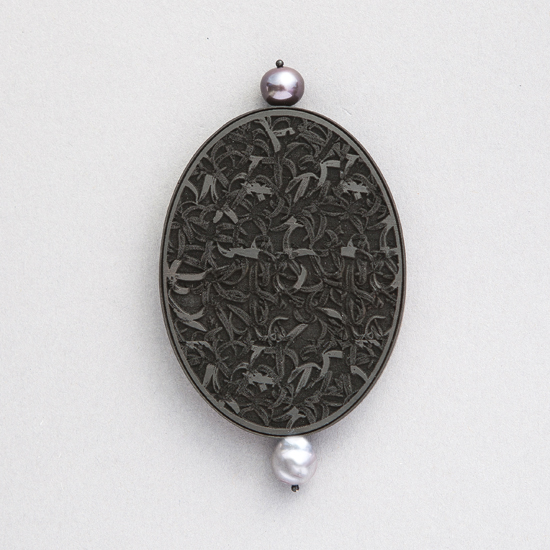
Tell us a little bit about yourself.
I am Jessie Seo. I am a final year student at Central Saint Martins. My designs were derived by my fascination of nature.
What was the inspiration for this collection?
My imagination started when looking at large pieces of dark bark that had really interesting textures. I wanted to manipulate the textures of the wood and explore the depth and texturized images engraved on the wood. The idea of engraving flowers on the wood has been the subject of my fascinatation with the material of wood.
I found an artist named Karl Blossfeldt. His black and white photographs of a flower’s buds, shoots and stems were magnified and their shapes were amazing. I was drawn to the images of his works and inspired me to engrave them immediately on the black ebony wood.
Combining natural material into jewelry gives me an emotion of wearing nature. My collection is a night garden. The beauty of blackness shines through moonlight that gently rests on this night garden. I have used the pearls to picture the moonlight on the black garden.
What have you discovered about working with pearls?
I have discovered that pearls are very delicate and it has very oriental and natural beauty that makes the jewelry’s beauty to its most height.
What’s next for you after CSM?
An MA in Italy!
Name one jewellery toolbox essential that you can’t live without.
Drill bits!
Name your favourite place for design in London.
London Zoo.
JUNKO KURIHARA
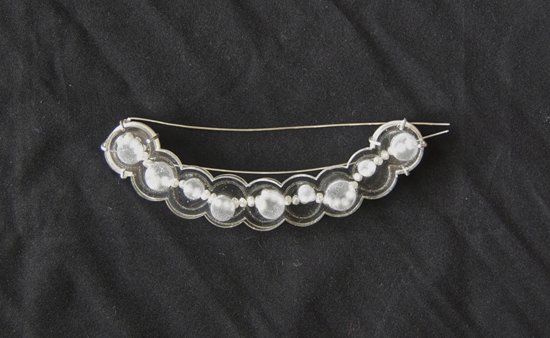
Tell us a little bit about yourself.
I am 23 years old and am from Japan.
What was the inspiration for this collection?
My inspiration came from the blurred images and eyesight, that occurs without wearing contact lenses or glasses.
What have you discovered about working with pearls?
That a natural pearl may have a beautiful colour that people are not able to create.
Who could you imagine wearing your jewellery?
My jewellery is designed for everyone who wants to wear it, but I would imagine particularly for ladies aged 40-50 years old.
What is your most treasured piece of jewellery?
An 18 carat gold ring that I bought with my first salary.
What’s your motto?
Be creative!
-
Central Saint Martins Jewellery 2014 - I
Central Saint Martins Jewellery 2014 - I
For the second year, we have been working with Central Saint Martins, the leading art and design centre based in London.
Our collaboration gives the student designers an opportunity to experience designing with pearls for their final year work, which is showcased at a sparkling Jewellery Awards Evening on 19th June. We will be awarding our Winterson Prize to one of the students for 'The Best Use of Pearls'.
The designs are also open to the public at CSM during June 18-22nd.
Here we feature the first in a four part series of short interviews with designers from the CSM Jewellery 2014 show, including in this article – Eleonora D'Ottavi, Elizabeth Lee, Emma Duckers, Felicia Swartling and Fortuna Weeks.
Read about some of the other designers in Part II, Part III and Part IV of our interviews here. Discover the Winner of the Winterson Prize 2014 here.
ELEONORA D’OTTAVI
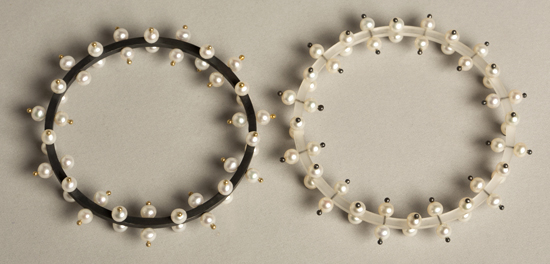
Tell us a little bit about yourself.
I am Italian although I have lived both in London and Geneva. In Geneva I became an intern in Christie’s jewellery department where I discovered Fine Jewellery. Since then I have been designing Contemporary/Fine jewellery.
What was the inspiration for this collection?
I wanted to create a collection which would transfer my personality and individuality into pieces of jewellery.
What have you discovered about working with pearls?
While writing my dissertation on the history of pearls I discovered that although natural pearls are incredibly symbolic, freshwater pearls are still without meaning even though they are just as beautiful.
What is it that makes a piece of jewellery a design classic?
I am not sure how to explain this, but there are some pieces of jewellery which make whoever is wearing them radiant, no matter what their age or style (both of the person and jewel). These are what I would consider a classic.
Which designer or artist do you most admire?
JAR
Name one jewellery toolbox essential that you can’t live without.
An antiseptic cream for burns.
ELIZABETH LEE
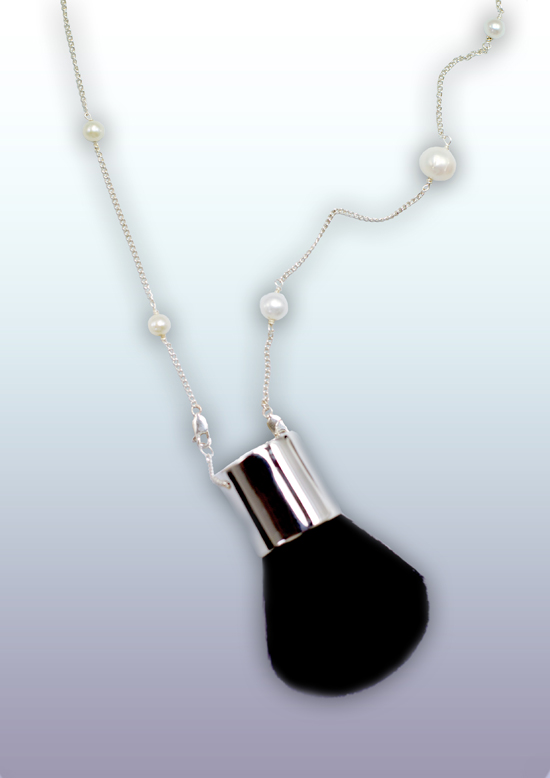
Tell us a little bit about yourself.
I am half Chinese, half Taiwanese, born and raised in London. I have studied at Central Saint Martins since foundation, initially wanting to study fashion design and eventually becoming inspired by jewellery through product design.
What was the inspiration for this collection?
The concept of my collection entitled “Play” is based on the idea of finding the beauty in objects by looking at the finer details we often dismiss. Merging cosmetics into jewellery became the main source of inspiration as the notion surrounding makeup defines play.
What have you discovered about working with pearls?
Pearls come in many sizes and shapes, each having its own unique character and lustre. For a few of my pieces, I worked with inlay and found that the rainbow shine could be reignited with a touch of water to recreate its mesmerizing appearance.
What’s next for you after CSM?
Designing anything product related for a company. Perhaps somewhere abroad!
What is your most treasured piece of jewellery?
A Yves Behar watch. The design is minimal and so innovative and beautiful!
Which designer or artist do you most admire?
Oki Sato for NENDO
EMMA DUCKERS
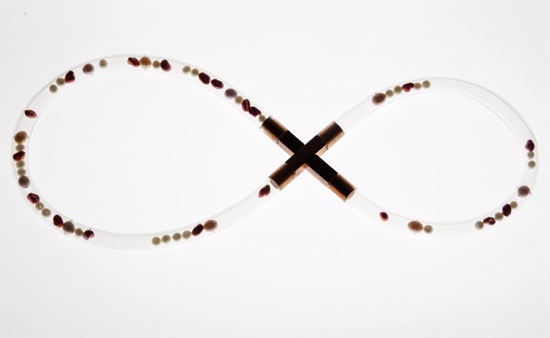
Tell us a little bit about yourself
I am a designer who is looking to alter some of the grey in today’s world.
What was the inspiration for this collection?
The impact of heart disease has been the driving force behind this collection, as it is a matter close to my own heart. This collection is to raise funds for research aimed at conquering Cardiovascular Disease, the biggest killer within the United Kingdom.
There is a focus on the dual aspect of the heart: ‘two pairs of two different kinds of chamber, two types of blood- oxygenated and deoxygenated, red and blue, two sides, two return journeys, two types of vessel: artery and vein; all with a unification in purpose’ (L.Young, The Book of the Heart, 2002).
The series of pearl pieces focuses on the circulation of the blood around the heart. The lathed and milled interlocking sections illustrate the inter workings of the heart, whilst also allowing the neckpieces to have a dual wearability factor. Taking a broad view into a healthy heart, through to the digression experienced with Cardiovascular Disease.
The collection has been informed by the scientific advancements made in the study of the treatment of heart disease up until the present day. It also makes a nod to the fact that this is part of an on-going process. We are not at the end of the road yet and the collection celebrates innovation and advancement as abstract ideas by themselves, whilst also translating into a striking, wearable, considered pieces.
What have you discovered about working with pearls?
Pearls I have found hold the importance of material relevance for my collection, in representing both red, white blood cells and plasma. Relevant from the way they are formed, considered as a natural material and ideal in the array of colours and forms available.
Not only used for their relevance to my concept, yet used in this way the pearls offer an elegant luster, in a considered contemporary design.
Who could you imagine wearing your jewellery?
Melinda Gates.
Which designer or artist do you most admire?
Rebecca Horn for her creative approach to the adornment of the body and spaces.
Name your favourite place for design in London.
The Victoria & Albert Museum hosts an array of inspiration from all over the world under one roof. No matter how many times I visit there is always something new to discover.
FELICIA SWARTLING
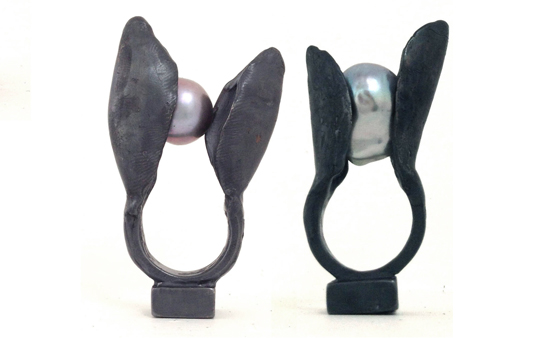
Tell us a little bit about yourself.
My name is Felicia Swartling, I am twenty-four years old and I am obsessed with jewellery. Where my love and hunger for jewellery has grown beyond anything I’ve ever felt before, to the point were Jewellery has to me become more then something that you just wear. It has become a part of me, almost like a language through which I can express myself.
What was the inspiration for this collection?
Similar to the framework of art and fashion, jewellery is also shaped by pre- conceptions that inevitably forms conventional jewellery to be conceived primarily as body adornment. When jewellery is not worn it is placed in a box, drawer or other encapsulating precious container to become invisible and obscured from further admiration. The jewellery box can therefore be seen as a parallel to the invisible space surrounding an exhibition or the stereotyped anonymous body on a catwalk.
With an equivalent shift of perception, my aim is to fuse features from other fields such as sculpture, flowers and African artefacts with jewellery to provoke the pre-conceptions that the conventional framework of jewellery may have.
Through the collection I have designed, I hope the wearer and viewer will re-evaluate the perception of what jewellery is and the value of its use. My collection consists of fifteen independent pieces of jewellery. Each piece has a dual quality; the ability to be worn, yet simultaneously does not require a body to be complete. The pieces have a sculptural quality to inhabit a space so to make the physical body irrelevant when they are displayed.
What have you discovered about working with pearls?
To work with pearls was a new experience and I’m now under their spell and intend to incorporate pearls in more upcoming collections.
What is it that makes a piece of jewellery a design classic?
Primal elements combined with futurism.
A design classic is something that possesses features from its history and tradition, yet fused with futuristic elements that when combined strikes as a contemporary piece with subtle connotations of heritage awareness.
What’s your motto?
No compromises. Shut up and work.
FORTUNA WEEKS
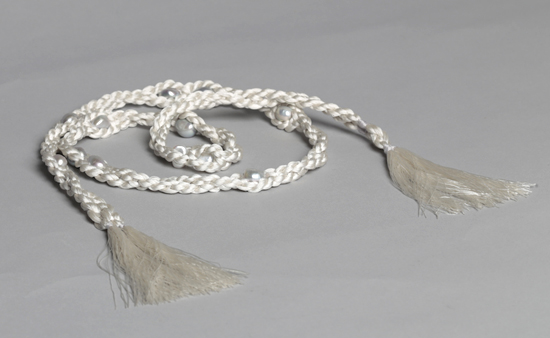
Tell us a little bit about yourself.
I was born in Cuba and raised in New York City. I danced professionally and taught Pilates whilst living in NYC. After relocating to London I became fascinated by the creative buzz that surrounded me and decided to pursue a BA in Jewellery Design at CSM.
What was the inspiration for this collection?
Two contemporary artists inspired me: Yeon Joo Ham, a Korean textile artist; and Jose Parla, a Cuban/American painter. Their pieces brought to mind the interconnection of threads.
I taught myself a selection of complex braids using the ancient art of Japanese braiding, Kumihimo. Whilst braiding I found that I could relate the sound and rhythm of the bobbins knocking against the loom to the natural cycles in nature, such as Water. My collection is based on all these ingredients.
What have you discovered about working with pearls?
They feel great, they are timeless, and I love the lustre of good quality pearls. They are beautiful and work well with my collection.
What is it that makes a piece of jewellery a design classic?
A piece of jewellery is a design classic when it possesses timeless aesthetic value. It can be worn and appreciated regardless of when it was made.
What is your most treasured piece of jewellery?
My mother’s bracelets. Their family history, craftsmanship and beauty make them a design classic.
Name your favourite place for design in London.
My favorite place for design is the Saatchi Gallery.